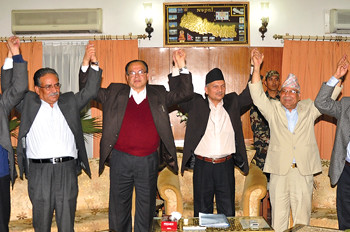
BIKRAM RAI
When Nepal’s
Maoists declared a ‘people’s war’ in 1996, they were ridiculed at home and abroad for being on the wrong side of the history. Within a dozen years they were leading a government in Kathmandu after winning an election.
There is a myth that Nepalis are a tolerant lot with a high threshold for pain. That may be true, but they have also revolted against state oppression. In their quest for freedom and dignity, they overthrew the Rana regime and supported BP Koirala’s socialist agenda in the 1959 election. In the 1990s, they followed Madan Bhandari and his concept of a New People’s Democracy. Post 2006, they supported Maoist demands for republicanism.
Sadly, Nepal’s leftist movement has neither been able to maintain its idealism nor defend its commitment to a free and equal society. While the NC dumped BP’s democratic socialism in favour of the Washington Consensus after 1990, the UML casually forgot Bhandari’s New People’s Democracy after his demise. The people were disappointed with both the parties and their corrupt leaders, who not only presided over infighting and mal-governance, but also failed to protect the country against Gyanendra Shah’s autocratic regime after 2001.
So despite violent political history and radicals threatening to capture the state by brute force, most Nepalis accepted Pushpa Kamal Dahal’s commitment to democratic and peaceful politics and voted his party into power. Four years later, they have been let down yet again.
“It is sad to see comrades who selflessly fought against this unjust state structure have shamelessly co-opted into the same system,” bemoans Maoist leader Ram Karki who used to be close to Baburam Bhattarai and has recently shifted to the Pushpa Kamal Dahal camp. At a program in Kathmandu this week to mark 65 years of the establishment of the original Nepal Communist Party, leftist leaders and thinkers came together to discuss what is left of the left in Nepal. Speaking at the program, Karki acknowledged that the UCPN-Maoist was undergoing an unprecedented ideological and moral crisis.
The party gained politically and had become financially stronger after 2008, but he admitted there has been erosion of ideological and moral moorings that had inspired selfless sacrifice in the party rank and file among leaders who are now becoming increasingly selfish and power hungry.
Another leftist leader, Ghanashyam Bhusal was equally critical of his UML and said that after 1990, the leadership failed to gauge the gulf between people’s aspirations and its own political program. “We never sat back and introspected why thousands of Nepalis were drawn to the Maoist’s ‘people’s war’ even though more than half of them voted for us in the elections. The UML made a mistake and now the Maoists are repeating it,” he said.
Despite being on the periphery of power for so long, Nepal’s leftist parties have always dominated the critical political discourse. Their interpretation of ‘material political conditions’ and vision of a just society have appealed to the masses.
But the duality in the behaviour of leaders reeks of hypocrisy and weak moral foundations. In private conversations, some leaders express personal distaste for ‘money and muscle’ politics, but go roundabout justifying it in the name of doing ‘larger good’. As former Prime Minister Baburam Bhattarai often likes to say: “These are small things, we should not be distracted by such details in the great course of revolution.”
The left’s proposal to seek a greater state role in the economy is significant in a remittance-driven economy for the upcoming elections. But before going to the people with their popular programs, the challenge for Nepal’s leftist parties is to overcome the crisis and contradictions within their own rank and file.